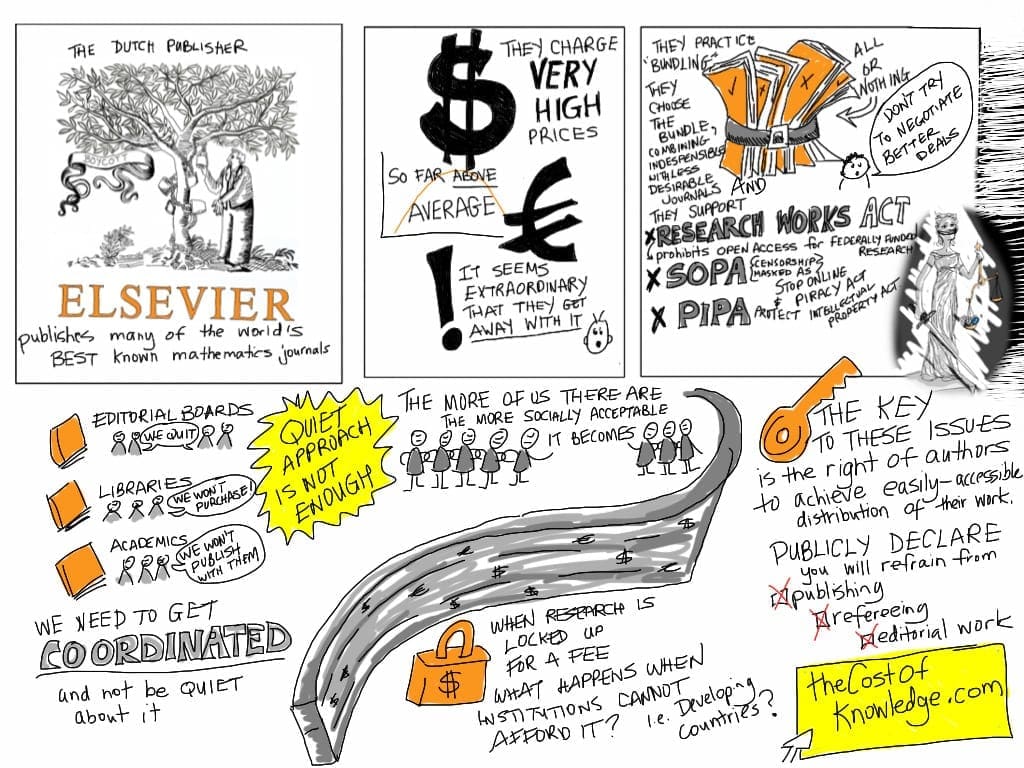
More and more private universities these days, are pushing their academicians to publish articles in academic journals and scientific journals that have a higher citation index and impact factor. Some universities even bear the publishing costs to these reputed journals with a high citation index and impact factor and provide further incentives in terms of promotions and conference travel and expenditure.
This shift is more prominent in private universities, especially in the developing nations like China and India, where universities are ranked lower in the global ranking scales. Most research conducted in these countries is published in academic journals with a lower citation index, more often because of a poorer language, compared to the high-standards set by scientific publications that have a higher citation index.
This doodle sums up the Cost of Knowledge for publsihing and subscibing to academic journals with a high citation index.Image Source: The ?Cost of Knowledge? ? On the Elsevier boycott and the push for more open access
The question that comes to mind is does it really matter if your research is published in a journal with a high impact factor? Isn’t the quality of the research more important than the language skills of the academician? Or for that matter, isn’t the research that gives value to the publication?
Adding more substance to the above argument is a study conducted by Paul Courant, a professor in economics and information at the University of Michigan (Ironically, this article is behind a paid subscription barrier). This study reveals that many universities are paying very high subscription charges to academic journals that are not open access, and that the value for money these academic journals give is not proportionate. The study found that many universities pay close to $1 million for access to journal packages from publishing houses with high citation index journals such as Elsevier. This kind of cost is difficult for universities in India, which simply do not have that amount to spend on research.
Considering these academic journals charge for subscriptions, in addition to the obvious revenue they receive from advertisement deals, why then do academicians need to pay to get published?
Academics feel they have to publish in the ‘right’ journals, and with Universities pushing for publications in the ‘right’ journals, the publishers are totally exploiting that fact.
And how much research work are academicians really doing for money? Most of the articles are written usually by salaried academics, and are reviewed and edited usually by salaried academics, who do not receive any incentives from the publishers. To put it simply, the only people who actually matter in an academic journal are the editor, the article authors, and the peer reviewers. None of these people are paid, so there is no excuse for charging tens of thousands of monies for their work. All the publishers are doing are the final bit of aligning, formatting and (e-)printing, which I’m sure costs way less than they are charging for it.
With most global university ranking scales, giving high weight-age to research published in academic journals having a high citation index and impact factor, this trend looks only likely to continue. The sooner universities wake up to this fact and start boycotting these journals in favour of non-profit ones, the better; if everyone does it, then academics won’t feel disadvantaged for publishing in something currently deemed ‘less prestigious’.
With the rise in open access academic journals and many online journals, isn’t it time that these elite academic journals with high citation index and impact factors be shown their place?




1 Trackback / Pingback